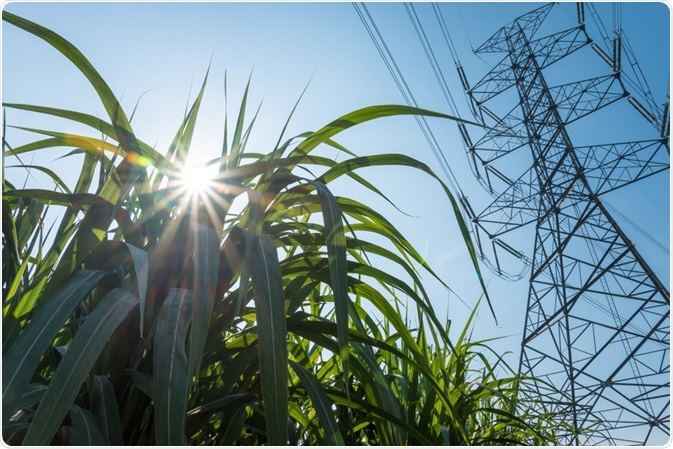The growing importance of tackling climate change is leading the increase in the development and adoption of renewable energy sources. Bioenergy is one such source that is seeing a rise in popularity. This article explores what bioenergy is and how it will be important in the future.
Bioenergy is a type of renewable energy that is produced in various ways using organic materials as a fuel. These materials are referred to as biomass and they can be made from any form of organic material that has used sunlight to create stores of chemical energy.

Image Credit: Pla2na/Shutterstock.com
The electric or gas that is produced from the stores in the biomass is known as bioenergy. Plants, timber, food and agricultural waste, sewage, algae, and organic residential/industrial waste can be used to generate this kind of energy.
How is bioenergy created?
Bioenergy converts biomass into a source of energy. Biomass can either be produced specifically for use in generating energy or, it can be a waste product of another process that finds use in creating renewable power.
The agricultural industry produces large amounts of waste that is recycled through its use in creating bioenergy. The food processing and timber industries also generate vast amounts of waste that can be recycled in the same way.
Bioenergy can be created in numerous ways, the method depends on the type of biomass, which also impacts the technology used and the type of energy that is released (usually as electricity or gas).
For example, liquid biofuels like ethanol and biodiesel are produced by crops such as corn, whereas manure is used to generate biogas that can produce electricity or biomethane which is used as a transport fuel.
Below, we discuss the main methods for creating bioenergy.
Anaerobic digestion
Under oxygen-free conditions, biomass is biologically breakdown via the natural process of anaerobic respiration. Biodigesters have been designed and developed to facilitate the anaerobic digestion of biomass.
A wide range of biomass sources can be digested in these biodigesters, although sewage, wet agricultural residues, and manure are the types it is best suited to.
These materials produce biogas once they are anaerobically digested, which is then combusted to create heat and power within a gas turbine. This biogas can also be developed to natural gas standards and used in the grid.
Conventional combustion
Combustion is the easiest method for obtaining power from biomass, which has resulted in it being the most commonly used technology. Combustion converts biomass into heat, which can then be used to generate electricity by powering a steam turbine or engine.
While the electrical efficiency of combustion is fairly low, at 20-35%, co-generation methods can achieve high efficiencies of up around 85%.
There are two main types of thermal combustion technologies. The first is fixed bed combustion. This is where the biomass is placed on a fixed grate and burned while air is passed through the gate to facilitate the combustion.
The other type is fluidized bed combustion where sand is mixed in with the biomass, turning it into a fluid-like substance. This helps it to burn more evenly, which increases its efficiency. The method is also suitable for a wider range of biomass types.
Gasification
During gasification, biomass is added into a gasifier and supplied with limited oxygen as it is heated to temperatures of 800-1000°C. This thermo-chemical process results in a partial burning of the biomass, with most of it being converted into what’s known as ‘syngas', a mixture of carbon monoxide, carbon dioxide, methane, hydrogen, and nitrogen.
Syngas can be used as a direct source of heat or power. It can also be converted into biofuel via the use of other emerging technologies.
While combustion is the most popular method of generating energy from biomass, gasification is more efficient.
Pyrolysis
Pyrolysis is a method similar to gasification. Using pyrolysis, the biomass is heated with a limited supply of oxygen, as it is in gasification, however, the method produces products that can be either solid, liquid, or gas.
The outcome of the process depends on the speed and temperature at which the biomass was heated. The resultant gases and liquids are then used to produce bioenergy.
Why bioenergy is important for the future
Recent figures estimate that bioenergy accounts for around 9.5% of the world’s total energy supply, which is predicted to rise to a third by 2023. It is the energy sector that is growing most rapidly, providing a renewable energy source in a time when governments around the world are pressured to completely abandon the use of non-renewables in a bid to tackle climate change.

Image Credit: Lua Carlos Martins/Shutterstock.com
Biomass will likely play an essential role in the global energy system of the future. Its use will have a significant impact on reducing carbon emissions. However, the processes involved in creating bioenergy need to be developed to ensure that they do not in themselves contribute to carbon emissions.
For example, the energy involved in the production and transportation of biofuels should be kept carbon neutral.
In addition, much farmland is being dedicated to growing produce to create biomass for bioenergy, a method with is counterintuitive given the looming food crisis. These issues will have to be tackled to ensure bioenergy offers a truly renewable energy source.
Sources:
- Creutzig, F., Ravindranath, N., Berndes, G., Bolwig, S., Bright, R., Cherubini, F., Chum, H., Corbera, E., Delucchi, M., Faaij, A., Fargione, J., Haberl, H., Heath, G., Lucon, O., Plevin, R., Popp, A., Robledo-Abad, C., Rose, S., Smith, P., Stromman, A., Suh, S. and Masera, O., 2014. Bioenergy and climate change mitigation: an assessment. GCB Bioenergy, 7(5), pp.916-944. https://onlinelibrary.wiley.com/doi/full/10.1111/gcbb.12205
- Modern bioenergy leads the growth of all renewables to 2023, according to latest IEA market forecast. Available at: www.iea.org/.../modern-bioenergy-leads-the-growth-of-all-renewables-to-2023-according-to-latest-iea-market-forecast
- Reid, W., Ali, M. and Field, C., 2019. The future of bioenergy. Global Change Biology, 26(1), pp.274-286. https://www.ncbi.nlm.nih.gov/pmc/articles/PMC6973137/
Further Reading
Last Updated: Oct 1, 2020